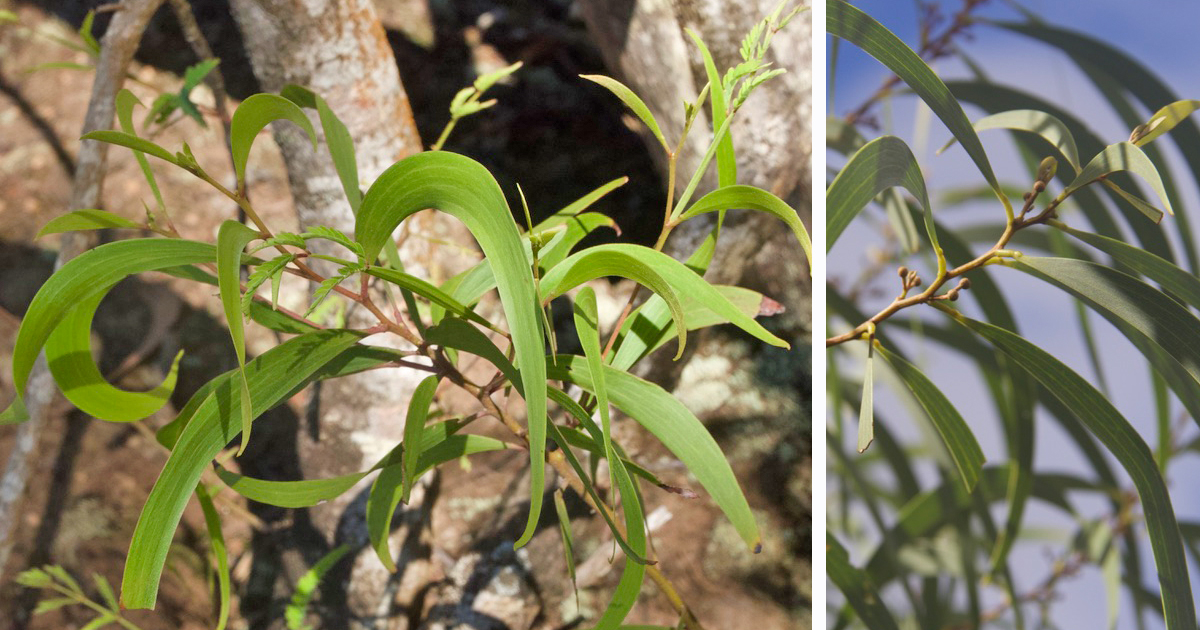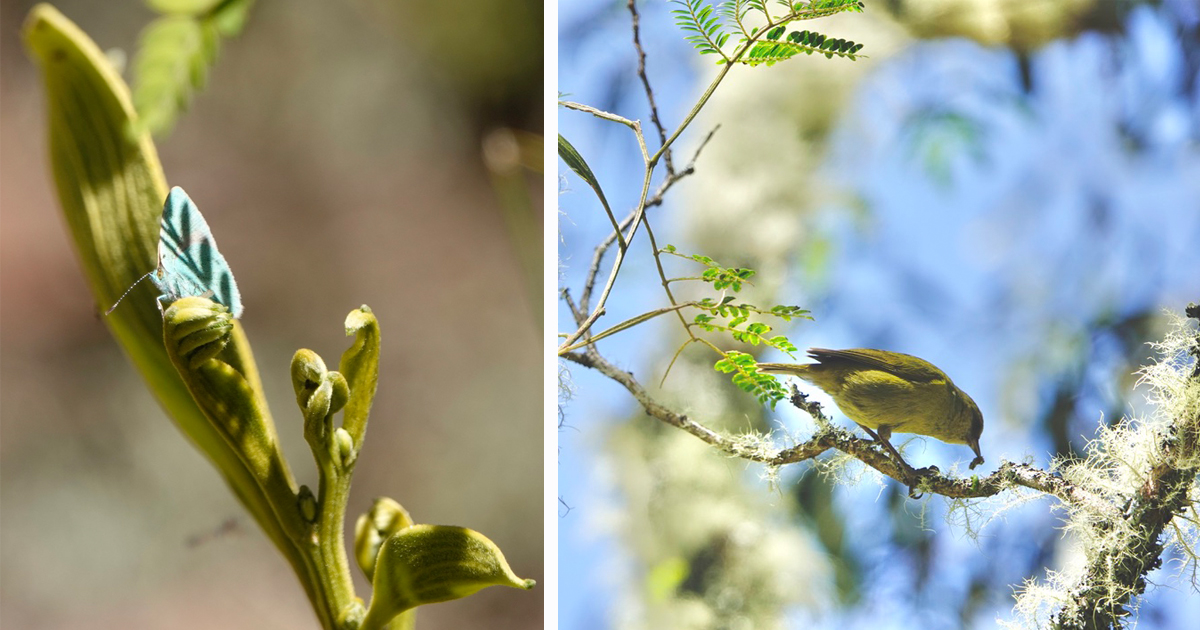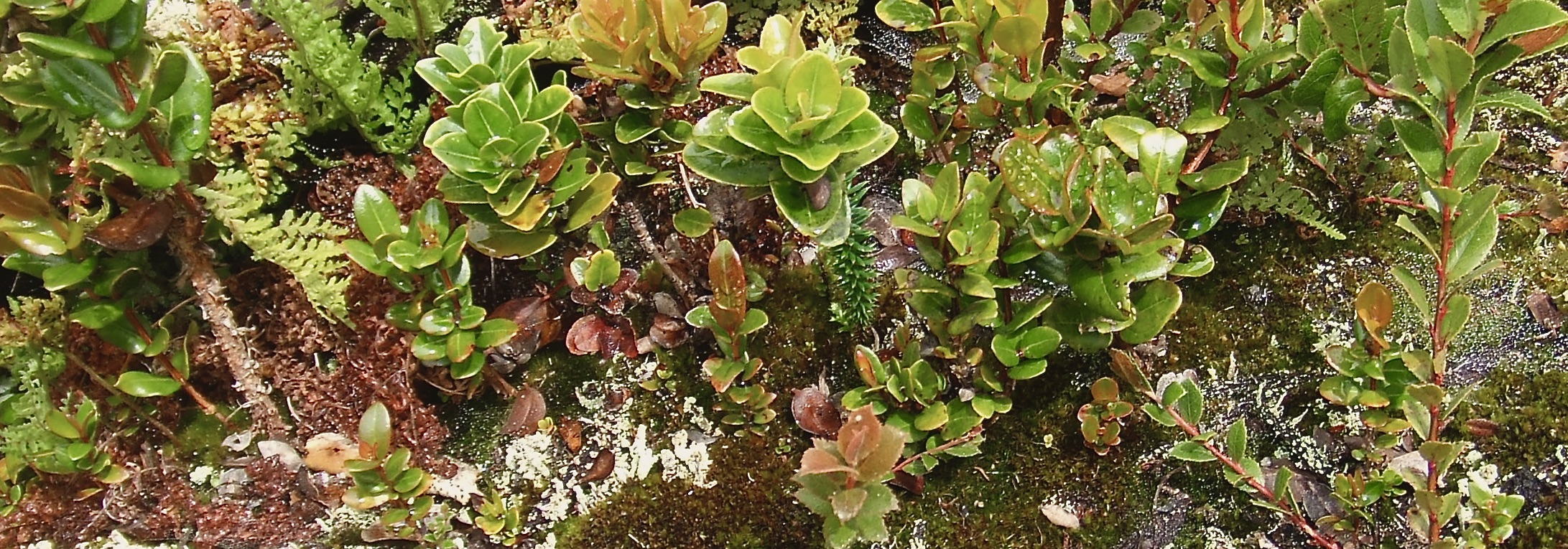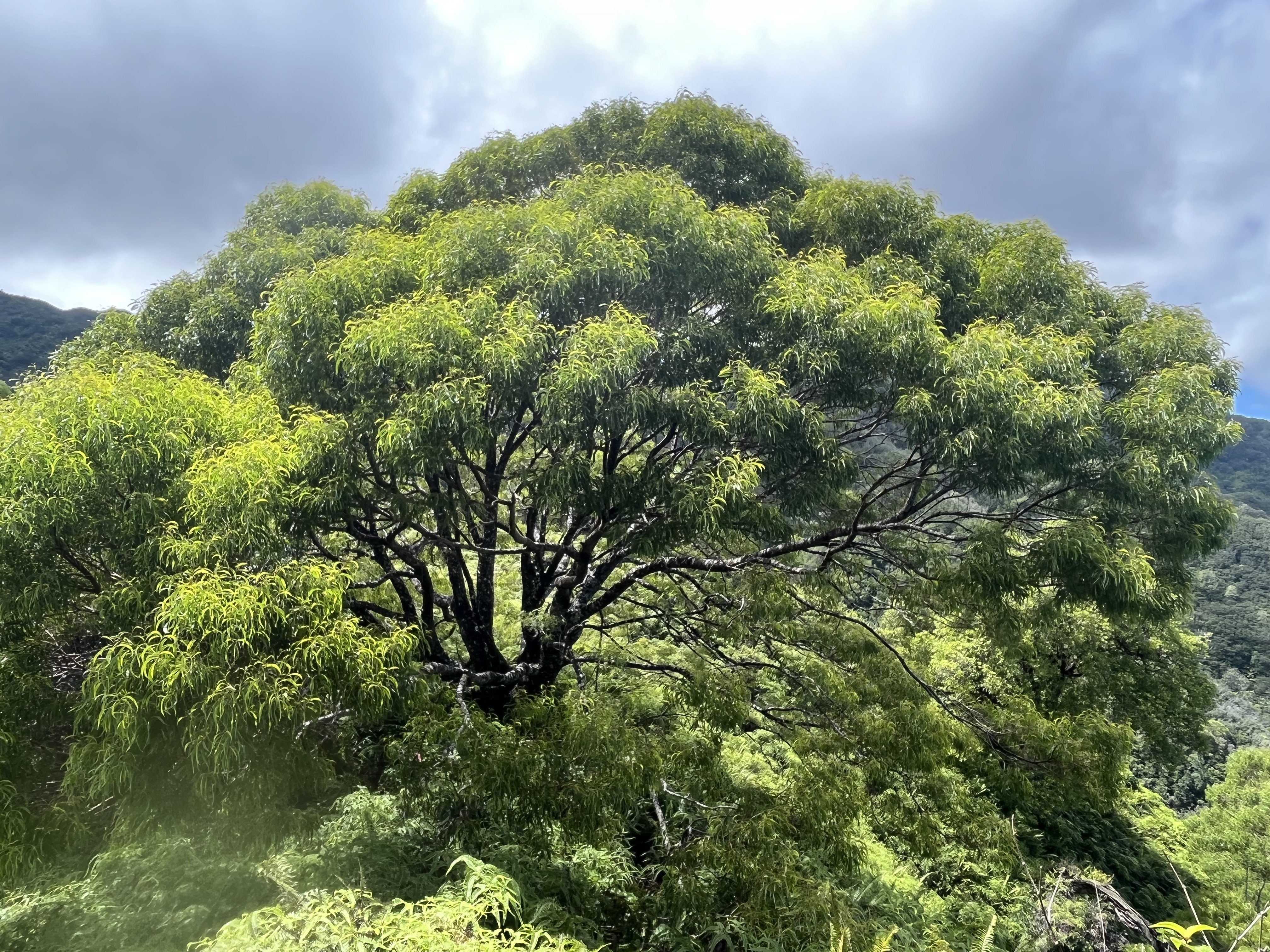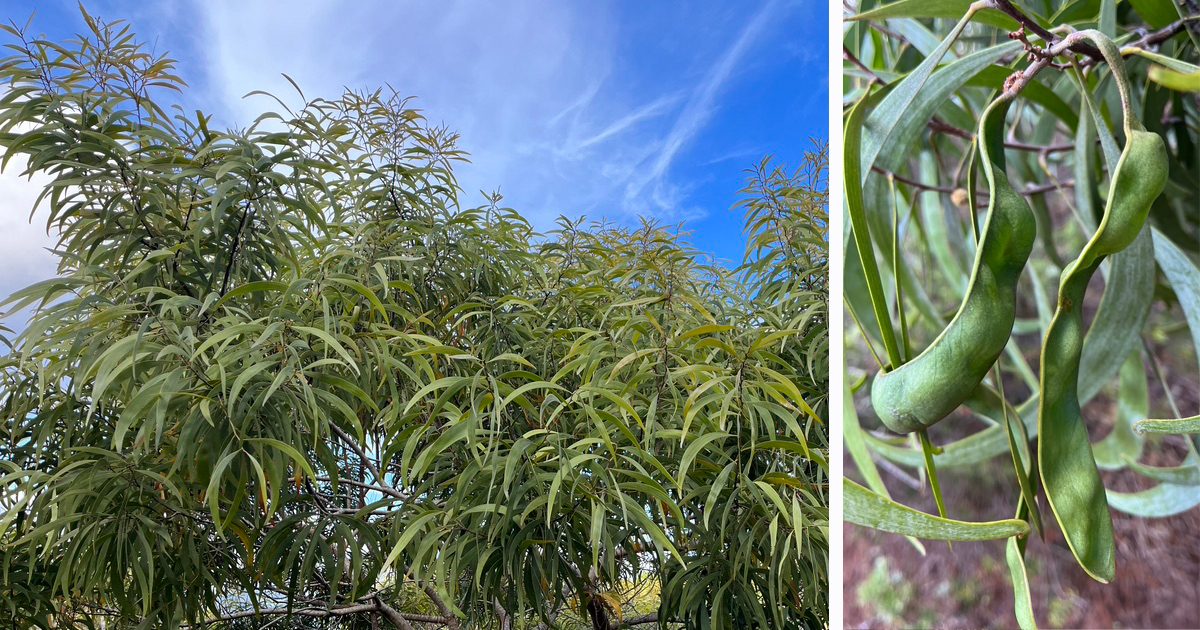Ulu Kanu: Acacia Koa
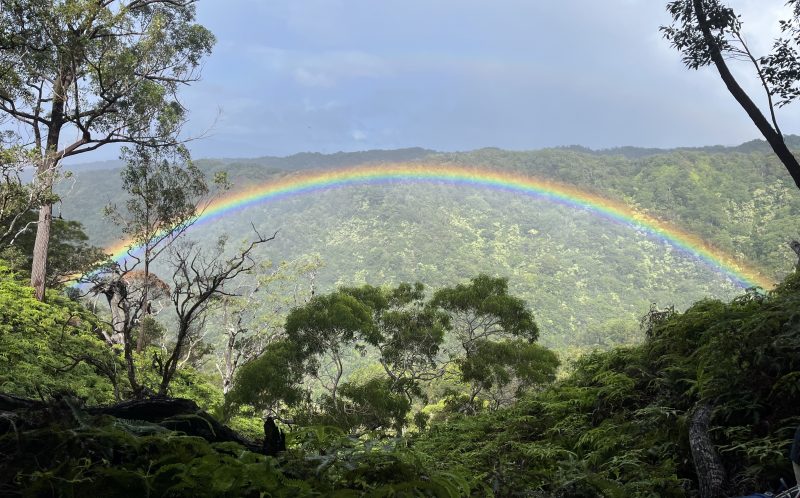
Why Koa?
I like to ask everyone what their favorite native plant is, if they have one. Recently, when I asked a couple people this question, they answered koa but then qualified their response saying that they knew it was a bit simple or maybe even generic. Well, koa is neither, so I thought this month I should highlight this truly standout tree. Really, if we’re going by how much a plant is part of the foundation of the forest and the culture, koa should’ve been featured a long time ago.
I am also biased because one of my nieces is named for the tree. The generic (but stunningly beautiful) name Acacia (uh-kay-shuh) is derived from the Greek, akakia, the name for Acacia arabica. The Greek word akis or ake means a sharp point, referring to the thorns of that plant.
More about Koa
Koa is endemic to the islands and belongs to the third largest plant family, Fabaceae (Pea or Legume). It is the largest native tree in Hawaiʻi, easily reaching heights of over 100 feet. As a juvenile, koa has compound leaves composed of many tiny leaflets. As it matures, koa produces phyllodes instead of true leaves. These are flattened, sickle-shaped structures that are the main photosynthetic organs of the plant. It also has yellow, cream, or white powder puff flowers that bloom sporadically but especially early in the year.
Koa is an important part of our forested watersheds, often serving as the dominant canopy species. Canopy species allow water to drip down slowly and protect from erosion. This is an essential part of a healthy Hawaiian watershed. A watershed is an area of land that collects rainwater (and cloud drip) into a common outlet (think mountains to the sea). Native plants, specifically, evolved for millions of years in this environment to effectively capture water and act as a sponge, absorbing water in the ground that leads to our aquifers and into our communities.
You would think that we would have protected this tree at all costs knowing what it does for our environment. But no. There are many places where planting koa has become an absolute necessity due to the loss of forests to grazing cattle (introduced to the islands in 1793) and invasive species. In the Hakalau Forest National Wildlife Refuge, for example, forests that took a long time to create were decimated in the years since Western contact. Therefore, the people at the refuge began dividing degraded lands into fenced management units and systematically removed wild cattle and pigs. They also removed invasives such as blackberry and gorse and planted over 350,000 native seedlings in 20 years. Koa was the very first plant they put in the ground. Years later, when a canopy was created, they added ʻōhiʻa.
HTMC enjoying koa and ʻōhiʻa on our March 2022 trip to Hakalau
Koa grows in symbiosis with a special bacteria called rhizobia. Rhizobia are essential for nitrogen fixation, a key process for restoring productivity to marginal or degraded land. Even though the term “nitrogen fixing plants” is widely used, it is only through the symbiotic association with rhizobia bacteria that the process takes place. With koa, even though there are many strains of the bacteria, only a very narrow range will form an effective partnership with the tree. It is a fragile relationship that creates a strong forest and is now partly dependent upon people being able to protect the land long enough for those relationships to form.
Speaking of relationships, having healthy koa in our forests usually means having healthy birds in our forest. Koa is home to many of our native honeycreepers and other birds. Adult Kamehameha butterflies (Vanessa tameamea) feed on fermented and bubbling sap oozing from damaged koa trees. The koa butterfly (Udara blackburni) can be seen fluttering about on young plants. The koa moth caterpillars (Scotorythra paludicola) feed only on koa and are capable of defoliating whole mature trees, which isn’t a great thing when an outbreak occurs.
Koa also has an important relationship with people. The young leaves were used to induce sleep when someone complained of cramps or fevers. Phyllodes were used as “stuffing” for pillows or mats or burnt and their ashes used on lesions. Of course, the prized wood continues to be used for many things such as paddles, ʻukulele, surfboards, furniture, bowls, and weapons.
One of the most important uses of koa was for waʻa (canoes). Wood was selected very carefully in canoe-making. If an ʻelepaio (Chasiempis sp.) or ʻalalā (Corvus tropicus) settled on a log when the canoe makers were going through the forest, any work to cut down that tree would be stopped and another would be selected. Birds meant insects, and insects meant holes or weak interiors. If all went well, though, the koa would be felled, ceremonies held, and the work of building begun. When completed, a fleet of canoes was often referred to as a koa grove in the sea.
Unfortunately, I have to refer to that process in the past tense in terms of voyaging canoes because, to my knowledge, there haven’t been any made from koa in a long time. In 1990, when the Polynesian Voyaging Society wanted to build Hawaiʻiloa out of traditional materials, there weren’t any koa in the forests large and healthy enough for the hulls. Instead, they were built out of two spruce tree logs gifted by elder Judson Brown of the Tlingit nation of southeast Alaska. But perhaps there are some suitable choices now?
Contents of one nurse log, a beautiful thing to behold
Anyway, even fallen or dying trees not used for other purposes have a place. Koa makes a great nurse log, allowing for the growth of new plants in likely an even richer environment than what is available on the forest floor.
Koa is also rich in meaning. As an integral part of a healthy ecosystem, so too is it an invaluable part of Hawaiian culture. Koa means “brave, bold, fearless, valiant; bravery, courage; soldier, warrior, fighter”. ʻŌlelo noeʻau 365 says, “E ola koa. Live like a koa tree. Live a long time, like a koa tree in the forest”. Good advice. Meanwhile, ʻōlelo noʻeau 398 says, “Haʻalele koa waʻa i koa kanaka. The koa canoe has departed leaving the warriors behind. Said when a canoe goes off and leaves the people behind, either in the water or on land”. Don’t be that canoe.
In short, koa is just wonderful. When you’re hiking, feel free to make friends with them. As always, tread lightly and be careful that you’re doing more good than harm, but definitely get up close when you can. Sit in wonder under their shade as their sprawling branches give you a sense of comfort. Watch quietly as manu (birds) come by for a quick visit. Hug one- at least one- before you leave.
How to Grow It
The seeds of Acacia koa are contained in brown bean pods 1/4 to 1 inch wide and up to 12 inches long. The oval seeds are less than 1/2 inch long. The seeds need to be removed from the dried pods by hand.
Some suggest doing an overnight soaking of the seeds in 3 or 4 times the amount of almost boiling water as you have seeds to speed germination. After this treatment, the seeds will probably start germinating in about 2 weeks. Either damp potting medium or damp paper towels can be used for germination.
Others suggest the seeds be scarified, using sandpaper or clippers, being careful to avoid damaging the inner part of the seed. After scarification, the seeds should be soaked in water for 24 hours and planted in a potting mix at a depth of about twice the diameter of the seed. Germination may then occur in about a week.
Lightly fertilize seedlings 2 or 3 weeks after secondary growth, and do not prune. Koa does best in full sun and, if you’ve got a big yard, spaced at least 30 feet apart.
Koa can grow quickly, about 5 feet a year at the start, but they sometimes become susceptible to disease after a decade or two. To ensure proper growth, do not use pesticides around the root area and be very careful with weed whackers and other tools that can cut into the plant and help rot set in. Rusts, pests like the black twig borer, aphids, and the koa seed worm can all damage the tree, so watch for those.
What Koa is Not
There are two endemic species of Acacia in the Hawaiian Islands: Acacia koa and A. koaia. Koaiʻa is sort of like Koa’s smaller, hard-wooded cousin. It is also, unfortunately, rare and at risk. Koaiʻa usually have straighter and narrower phyllodes than koa. Its seeds are arranged in pods end-to-end (vertical) as opposed to the side-by-side (horizontal) arrangement in koa. When the seeds seem to go diagonally or alternate directions, it is likely a hybrid. Koaiʻa was also used for many items but not for canoes because its wood is curly grained.
Some people confuse Formosa koa (Acacia confusa– says it right there in the name) for our native tree. Koa, however, grows taller, has more curved phyllodes, and has longer pods. Formosa koa is native to Taiwan and the Philippines.
Koa haole/False koa (Leucaena leucocephala) can also look somewhat similar to koa, but it is invasive. They were brought in to feed livestock, but they’re not very good at that. They are, however, easy kindling for brush fires and very difficult to remove. The seeds, pods, and flower buds can all be eaten after careful preparation, though, so that is one way we might be able to help control them.
Formosa Koa (L) and Koa Haole (R)
Also, a little side language lesson…You might hear people say koa haole or haole koa. In terms of colloquial use, both are generally acceptable. However, in Hawaiian grammar, adjectives follow nouns. So, in this case, koa is the noun, and haole (foreign) is the adjective.
Sources
https://archive.hokulea.com/index/founder_and_teachers/judson_brown.html
https://cms.ctahr.hawaii.edu/forestry/Education-Outreach/Forestry-Pests-Diseases/Koa-Moth
https://www.ctahr.hawaii.edu/gsp/doc/Forestry/Little_Skolmen_CFT/CFT_Acacia_confusa.pdf
https://www.ctahr.hawaii.edu/hawnprop/plants/aca-koa.htm
http://data.bishopmuseum.org/ethnobotanydb/ethnobotany.php?b=d&ID=koa
https://www.fs.usda.gov/rm/pubs/rmrs_p024/rmrs_p024_139_142.pdf
https://hawaiihomegrown.net/talking-story/518-pulelehua-mamaki-and-koa
http://nativeplants.hawaii.edu/plant/view/acacia_koa/
http://nativeplants.hawaii.edu/plant/view/Acacia_koaia/
https://www.nwf.org/Magazines/National-Wildlife/2008/Rebirth-of-a-Hawaiian-Forest
http://oiwi.tv/
https://sunnysavage.com/2021/06/01/haole-koa-hui/
https://wehewehe.org/

